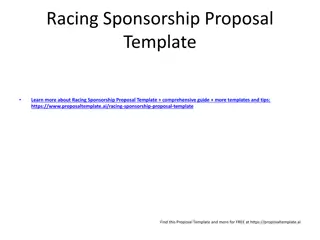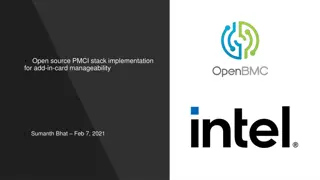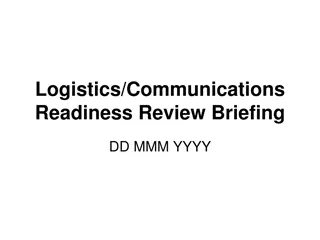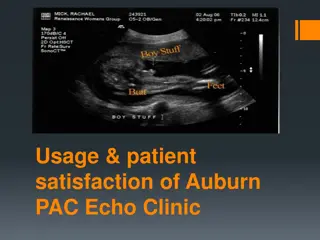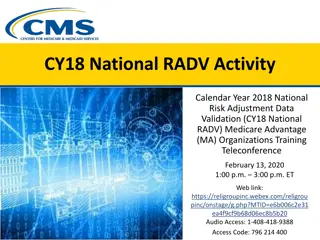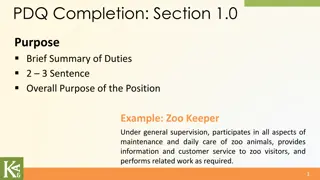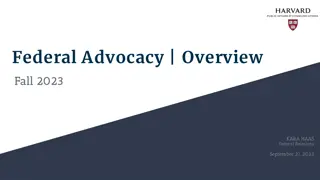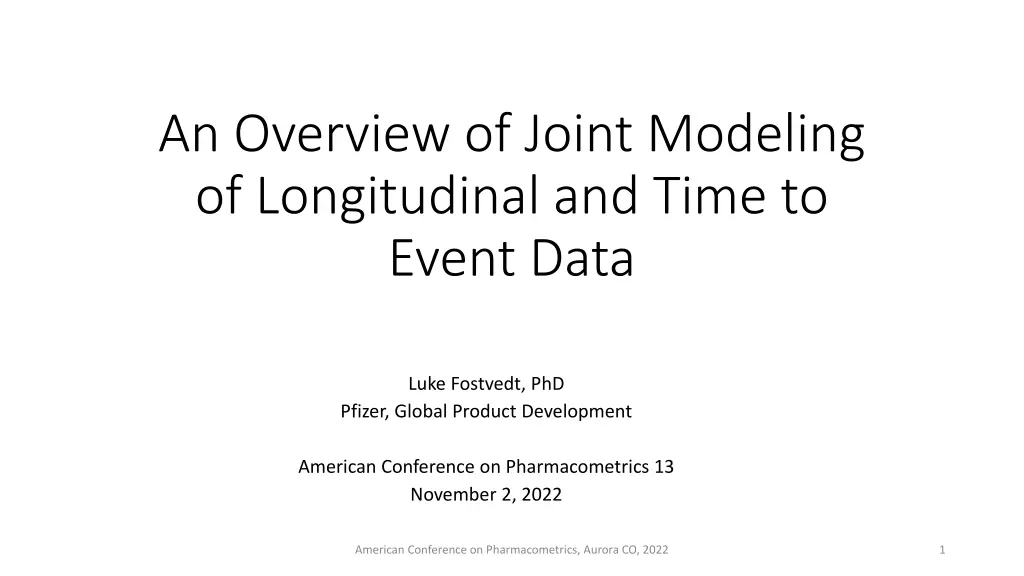
Joint Modeling of Longitudinal and Time-to-Event Data Overview
Explore the merging of longitudinal and time-to-event data in medical research through joint modeling. Learn about its components, estimation approaches, and applications for dynamic risk predictions. Enhance your understanding of how to maximize knowledge from collected data and predict clinical risk effectively.
Download Presentation

Please find below an Image/Link to download the presentation.
The content on the website is provided AS IS for your information and personal use only. It may not be sold, licensed, or shared on other websites without obtaining consent from the author. If you encounter any issues during the download, it is possible that the publisher has removed the file from their server.
You are allowed to download the files provided on this website for personal or commercial use, subject to the condition that they are used lawfully. All files are the property of their respective owners.
The content on the website is provided AS IS for your information and personal use only. It may not be sold, licensed, or shared on other websites without obtaining consent from the author.
E N D
Presentation Transcript
An Overview of Joint Modeling of Longitudinal and Time to Event Data Luke Fostvedt, PhD Pfizer, Global Product Development American Conference on Pharmacometrics 13 November 2, 2022 American Conference on Pharmacometrics, Aurora CO, 2022 1
Outline In this presentation I will discuss: What is joint modeling of time to event data and examples Joint Modeling Development Components Estimation approaches (sequential vs simultaneous) Bayesian Joint Modeling for Time to Event Data Applications of Joint Models for Time to Event Data with available stan code. Resources (if you download the slides) American Conference on Pharmacometrics, Aurora CO, 2022 2
Context In medical research, we frequently want to understand whether (some function of) a longitudinal outcome is associated with the risk of the event We may collect longitudinal repeated measurements of biomarkers or other measurements, that we think may be important for understanding how a treatment is working. That is, we think the repeated measurements over time (eg biomarker) may have predictive value. We may also have collected data on the time to some event (TTE) (eg dropout, death, transplant rejection, hospitalization(s), etc) How do we maximize the knowledge we can gain for the data we collected? Can we use the models to predict clinical risk? Possibly other reasons: adjusting for informative dropout, separating out direct and indirect effects of treatment, etc. American Conference on Pharmacometrics, Aurora CO, 2022 3
Why Joint Models Dynamic Risk Predictions Joint modeling is the basis of many models using for Pharmacometric applications. The idea behind these models is: To describe the evolution of a biomarker/covariate over time for each subject Use the estimates for each subject s longitudinal outcome in a time-to-event model Covariates do not need to be constant and can vary over time. Can handle endogenous time-varying covariates that impact the hazard/survival in time to event analyses We can make Dynamic Risk Predictions for the occurrence of an event. American Conference on Pharmacometrics, Aurora CO, 2022 4
Joint Modeling of longitudinal and time to event data Treats the longitudinal biomarker(s) and the event as outcome data. Broadly speaking, joint modeling is the estimation of two or more statistical submodels into a single joint model. Each outcome is modelled using a distinct submodel: A linear or non-linear, multivariate mixed effects model for the longitudinal outcome(s) A proportional hazards model for the time-to-event outcome(s) The regression submodels are linked through shared individual-specific parameters and estimated simultaneously under a joint likelihood function. Joint models provide more efficient estimates of the treatment effects on the time to event and the longitudinal marker, and reduce bias in the estimates of the overall treatment effect American Conference on Pharmacometrics, Aurora CO, 2022 5
Biomarker(s) linked to time event(s) Hypothetical Multiple Hazards (competing risks) PBC dataset: Multiple Biomarkers Log(serum Bilirubin): Cont. D-penicil: Cont. Log(spiders): binary Stem Cell Count Death hd(t) Transplant ht(t) Death hd(t) American Conference on Pharmacometrics, Aurora CO, 2022 6
Example: Who should get a liver transplant? How should the effect of disease development over time affect patient outcomes? Both patients had end-stage liver disease and need a transplant? A liver is available. Who gets priority? Patient A or B? Patient A s disease is currently more severe, but relatively stable. Patient B s disease is currently less severe but worsening rapidly. The link function in a joint model may need to account for more than just the current value of the longitudinal measurement. A joint model can account for the time course, rate of change, and many other links to estimate a dynamic/relative risk for each patient. A joint model using the disease severity and survival was developed to estimate the 90-day survival probability. Two Hypothetical Patients Source: Goudsmit et al (2021) Am J Transplant. 2021; 21:3583 3592. https://doi.org/10.1111/ajt.16730 American Conference on Pharmacometrics, Aurora CO, 2022 7
Benefits/Challenges of Joint Modeling Benefits Joint models provide more efficient estimates of the treatment effects on the time to event and the longitudinal marker and can reduce bias in the estimates of the overall treatment effect. Incorporating the longitudinal data into the design of a study has the potential of a lower sample size and increase power. Challenges Computationally intensive Depends on assumptions about random effects American Conference on Pharmacometrics, Aurora CO, 2022 8
Joint Model with Two Submodels ??? = ??? + ??(?) longitudinal mean: i(t) 1 ? ?1+ ?? ??(?) ??? = ? ?? Error: ei(t) Observed Data over time: Yi(t) Longitudinal Covariates Xi(1)(t) ??? = link function based on: yit ,??? ,?? 2 ? ?2+? ??(?)) ?? ??(?) = 0? exp(?? Fixed Effects: (1) Random Effects: i(t) ??? is a latent process that captures the association structure ( link ) between the measurement and event processes. Covariates can be shared in both (multiple) submodels. Random effects are shared across at both models using a link function. Can be extended to multiple submodels via the link function. Time to Event Link Fixed Effects: (2) function: gi(t) Covariates Xi(2)(t) Hazard Function: hi(t) Observed (Ti) Time to Event Figure Source: Hickey et al. BMC Medical Research Methodology (2016) 16:117 American Conference on Pharmacometrics, Aurora CO, 2022 9
Biomarkers and/or multiple time events Hypothetical Multiple Hazards (competing risks) PBC dataset: Multiple Biomarkers Log(serum Bilirubin): Cont. D-penicil: Cont. Log(spiders): binary Stem Cell Count ?2?2?? ?1?1?? ?2?2?? ?1?1?? ?3?3?? Death hd(t) Transplant ht(t) Death hd(t) American Conference on Pharmacometrics, Aurora CO, 2022 10
Some association (link) structures Table Source: Hickey et al. BMC Medical Research Methodology (2016) 16:117 American Conference on Pharmacometrics, Aurora CO, 2022 11
Additional Examples: Lagged association link function Cavender et al. (1992, J. Am. Coll. Cardiol.) conducted an analysis to test the effect of cigarette smoking on survival of patients who underwent coronary artery surgery. patients who smoked had higher probability of survival most of who died were smokers but had stopped smoking by their last follow-up (lagged effect) Current Value: (aids dataset available in R) CD4+ lymphocyte counts or viral load are measured repeatedly to assess patients health until HIV conversion. Current Value and Current Slope: (pbcSurv and pbcLong available in R) Mayo Clinic s primary biliary cirrhosis (PBC) and overall survival from patients who participated in a randomised placebo-controlled trial of D-penicillamine American Conference on Pharmacometrics, Aurora CO, 2022 12
Software for Joint Modeling Many different options are available: 1. R libraries library(JM) (http://jmr.r-forge.r-project.org/) library(JMbayes2) (https://drizopoulos.github.io/JMbayes2/) Bayesian and Frequentist options additional packages: joinR, joineRML, bamlss, lcmm, frailtypack 2. Stan stan_jm (use with rstanarm) rstan, cmdstanr custom stan (typically Bayesian uses) Others: Monolix, SAS, NONMEM, BUGS/JAGS American Conference on Pharmacometrics, Aurora CO, 2022 13
Estimation Approaches As the complexity of the model increases, the number of random effects will increase which creates computational difficulties. The most common approaches for modeling these: 1. Two-stage Estimation (ok but usually introduces bias) Assumes independence between the submodels conditional on the random effects. Bias in estimates increases with larger measurement error in longitudinal submodel. 2. Joint Sequential estimation (Can minimize bias similar to the simultaneous approach): Estimate population parameters and then fix those for the survival submodel Population PK parameter and individual PK data method from Zhang et al 2003 3. Simultaneous Estimation Unbiased unless model mis-specified. 4. Bayesian Estimation (best or worst depending on ideology) Can be sensitive to the selection of priors. American Conference on Pharmacometrics, Aurora CO, 2022 14
Two-Stage Estimation Two common approaches: Estimate the longitudinal submodel(s) Step 1a: 1. Estimate the longitudinal models a) Can calculate some model based metrics for use as covariates in the proportional hazards submodel (eg Week 8 tumor reduction) b) Can estimate the longitudinal trajectory for use as an endogenous time-varying covariate when fitting the survival submodel. Step 1b: Calculate model based summary metrics Calculate the longitudinal trajectory And/or 2. Estimate the proportional hazards submodel using the approach in 1(a) and/or 1(b) assuming estimates from fixed effects from step 1 are truth . Limitations/Assumptions: The main weakness of this methodology is that by ignoring the joint nature between both processes, the estimates of the survival regression parameters are often biased. Assumes independence between the submodels. Bias in estimates increases with larger measurement error in longitudinal submodel. Estimate the proportional hazards submodel using the results from the longitudinal submodel Step 2: American Conference on Pharmacometrics, Aurora CO, 2022 15
Two-Stage Estimation Examples 1. Wang et al (2009): A dynamic tumor growth inhibition (TGI) model was developed to understand the relationship between tumor dynamics and survival. The predicted percent tumor reduction at Week 8 was found to be a significant predictor of survival. Wang et al (2009): https://doi.org/10.1038/clpt.2009.64 2. Goudsmit et al (2021): Joint modeling of liver transplant candidates outperforms the model for end-stage liver disease: The effect of disease development over time on patient outcome. The JMs predicted survival using both the value of the MELD(-Na) score (a measure of disease severity considered predictive of the 90-day risk of death) and its rate of change at each moment in time (i.e., time-dependent slope). Concluded these predictions could more accurately direct treatment to those most in need. Source: Goudsmit et al (2021) Am J Transplant. 2021; 21:3583 3592. https://doi.org/10.1111/ajt.16730 3. Tsiatis et al (1995). Modeling the relationship of survival to longitudinal data measured with error. Applications to survival and CD4 counts in patients with AIDS. J. Am. Stat. Assoc. 90, 27 37. DOI: https://doi.org/10.1080/01621459.1995.10476485 American Conference on Pharmacometrics, Aurora CO, 2022 16
Joint Sequential Estimation Step 2: Estimate the Joint Model using all data. Step 1: Will focus on the method from Zhang et al (2003) referred to as Population PK Parameters and Data (PPP&D) This method has been shown to limit the bias compared to two- stage approach. Can better account for the joint nature of the processes Less computationally intensive than simultaneous joint modeling. Estimate the longitudinal submodel(s) Fix Population Parameter Estimates for the longitudinal submodel(s) Estimate the proportional hazards submodel and longitudinal model simultaneously American Conference on Pharmacometrics, Aurora CO, 2022 17
Simultaneous Estimation Estimate all the parameters in the joint model simultaneously Pros: Estimates are all unbiased provided the model is specified correctly. Relationship between the joint nature of the processes is maintained. Cons: The approach is generally very computationally intensive. As the number of random effects increases, the computational burden increases as well as the risk of convergence issues increases. American Conference on Pharmacometrics, Aurora CO, 2022 18
Sequential/Simultaneous Estimation Example D sm e et al (2015): Nonlinear Mixed-Effect Models for Prostate-Specific Antigen Kinetics and Link with Survival in the Context of Metastatic Prostate Cancer: Comparison by Simulation of Two-Stage and Joint Approaches Model Assumed prostatic cells proliferate with rate r and eliminated with rate d in the absence of treatment. Prostrate-specific antigen is secreted with production rate p and cleared with rate . Chemotherapy is assumed to block cell proliferation. Prostrate-specific antigen concentrations were used as a covariate (link) in the survival model. Estimation: (compared bias and relative estimation error [REE]) Simultaneous was always the best approach Two-stage had the largest bias and largest REE. The joint sequential method estimates were almost as good as the simultaneous approach (in terms of bias), but the REE was the largest in some scenarios. Source: The AAPS Journal, Vol. 17, No. 3, 2015. DOI: 10.1208/s12248-015-9745-5 American Conference on Pharmacometrics, Aurora CO, 2022 19
Bayesian Estimation Two-stage and simultaneous estimation approaches can be used. Pros: Cons: Prior information can be incorporated May be sensitive to the choice of priors asymptotic approximations are not necessary Covariate evaluation is more complicated computational implementation is typically much easier, and historical data (prior) can be incorporated easily into the inference procedure Computationally and time intensive MCMC may simplify estimation since complex multi-dimensional integration over the random effects can be challenging Ease of incorporating hierarchical data Simulations from the Posterior distribution may be simpler In some cases may show superiority compared to Maximum likelihood methods with respect to bias, root-mean square error, and coverage (Liu and Li 2014) American Conference on Pharmacometrics, Aurora CO, 2022 20
Bayesian Joint Modeling Example Alvarez et al (2021): A tractable Bayesian joint model for longitudinal and survival data Bayesian Joint Model of the aids dataset. a) Compare different hazards for progression from HIV to AIDs using a linear mixed model. b) Included dual hazard functions: treatment intolerance and treatment failure 1. 2. Bayesian Joint Modeling of competing risks of treatment failure in the SANAD study (Standard and New Anti-epileptic Drugs). 1. Patients withdraw either due to ineffective treatment, or unacceptable AEs. 2. Uses a linear longitudinal mixed model with log-normal baseline hazard 3. In both examples the random effects were used as the link structure 4. Also present model comparison using the posterior model probability. 5. R and stan code available at: https://github.com/daniloalvares/Tractable-BJM Source: Alvarez and Rubio 2021: Statistics in Medicine. 2021;40:4213 4229. https://doi.org/10.1002/sim.9024 American Conference on Pharmacometrics, Aurora CO, 2022 21
Dynamic Risk Assessment Using the joint model, dynamic risk assessments can be made for patients. Example with The Mayo Clinic s primary biliary cirrhosis (PBC) data from patients who participated in a randomised placebo controlled trial. Dynamic Risk predictions can be obtained using the longitudinal values up to a given time. Source: Billeman et al. Joint longitudinal and time-to-event models via Stan. https://cran.r-project.org/web/packages/rstanarm/vignettes/jm.html American Conference on Pharmacometrics, Aurora CO, 2022 22
stan_jm() function within rstanarm The stan_jm() function can be used for joint modeling of generalized linear mixed effects submodels together with a survival submodel. The longitudinal submodel (in the case of only a single submodel) is assumed to be a generalized linear mixed effects model. The submodel for the hazard uses a parametric hazards regression model. Baseline hazard can be specified as an approximation using B-splines on the log hazard scale (the default); a Weibull distribution; or an approximation using a piecewise constant function on the log hazard scale (sometimes referred to as piecewise exponential) American Conference on Pharmacometrics, Aurora CO, 2022 23
Stan_jm association structures The dependence between the longitudinal submodel(s) and the event submodel are captured via an association parameter. The stan_jm() function has several different association structures. current value current slope area under the curve or expected value Interactions between the biomarker Interactions between the biomarker (or it s slope) and observed data lagged values of any of the above can specify time-independent function of the random effects. note: more than 1 association structure can be specified. Source: https://cran.r-project.org/web/packages/rstanarm/vignettes/jm.html American Conference on Pharmacometrics, Aurora CO, 2022 24
stan_jm example Used the Mayo Clinic PBC dataset to illustrate estimation of a joint model with stan_jm() library(rstanarm) mod1 <- stan_jm(formulaLong = logBili ~ sex + trt + year + (year | id), dataLong = pbcLong, formulaEvent = survival::Surv(futimeYears, death) ~ sex + trt, dataEvent = pbcSurv, assoc = c("etavalue", "etaslope"), time_var = "year", chains = 1, refresh = 2000, seed = 12345) American Conference on Pharmacometrics, Aurora CO, 2022 25
Stan_jm() Additionally stan_jm() has functionality for: Posterior predictions for in-sample individuals for all submodels Posterior predictions for out-of-sample individuals (ie dynamic predictions) Predicted Population Level longitudinal trajectory And more See the Vignette on CRAN for the complete example Source: https://cran.r-project.org/web/packages/rstanarm/vignettes/jm.html American Conference on Pharmacometrics, Aurora CO, 2022 26
Two-Stage Bayesian Joint Model Leiva-Yamaguchi and Alvares (2021) presented a two-stage approach with an informative prior to correct for bias. They propose an additional parameter to the hazard submodel ??> 0 and E(??) = 1. ?? ??(?) = ?? 0? exp ??? ? + ? ??? where ?? > 0 denotes a multiplicative fixed-effect for individual i and calculated in the same way as the standard two-stage approach. Proposal a very small perturbation using an individual fixed-effect. They show this can satisfactorily correct the estimation bias and may even correct problems of misspecification and unobserved heterogeneity. ??(?) is Source: Leiva-Yamaguchi and Alvares, A Two-Stage Approach for Bayesian Joint Models of Longitudinal and Survival Data: Correcting Bias with Informative Prior. Entropy 2021, 23, 50. https://doi.org/10.3390/e23010050 American Conference on Pharmacometrics, Aurora CO, 2022 27
Bayesian Model Comparison (posterior model probability) 1. Berger J, Molina G. Posterior model probabilities via path-based pairwise priors.Stat Neerland. 2005;59(1):3-15. https://doi.org/10.1111/j.1467-9574.2005.00275.x Kass R, Raftery A. Bayes Factors.J Am Stat Assoc. 1995;90(430):773-795. https://doi.org/10.2307/2291091. 2. American Conference on Pharmacometrics, Aurora CO, 2022 28
Joint Modeling using stan The next two Presentations will show Bayesian applications using stan for joint modeling of nonlinear longitudinal models with time to event data. 1. Marion Kerioui: Use of joint modeling in oncology drug development: Challenges and opportunities. 2. Daniela Conrado and Yuhuan Wang: Nasopharyngeal viral load reduction with early administration of anti SARS-CoV-2 monoclonal antibodies was associated with decreased risk of disease progression in non-hospitalized patients with SARS-CoV-2 Alvarez and Rubio (2021) is a good resource since the stan code is available on github. Stat in Med. 2021;40:4213 4229. https://doi.org/10.1002/sim.9024 https://github.com/daniloalvares/Tractable-BJM American Conference on Pharmacometrics, Aurora CO, 2022 29
Some Good Tutorials and Resources 1. Joint Modeling of Longitudinal and Time-to-Event Data with Applications in R Dimitris Rizopoulos, Department of Biostatistics, Erasmus University Medical Center Course Slides: https://www.drizopoulos.com/courses/EMC/ESP72.pdf 2. Joint longitudinal and time-to-event models via Stan (stan_jm) Stancon 2018 talk by Sam Brilleman https://github.com/stan-dev/stancon_talks/blob/master/2018/Contributed-Talks/03_brilleman/notebook.pdf video of talk: https://youtu.be/8r-Ipt885FA 3. A workflow for the joint modeling of longitudinal and event data in the development of therapeutics: Tools, statistical methods, and diagnostics Tutorial in CPT:PSP, Zhudenkov et at 2021. https://doi.org/10.1002/psp4.12763 4. Joint modeling of survival and longitudinal non-survival data: current methods and issues. Report of the DIA Bayesian joint modeling working group. Stat Med. 2015;34(14):2181-95. https://doi.org/10.1002/sim.6141 5. Bayesian joint modelling of longitudinal and time to event data: a methodological review. Alsefri et al. BMC Medical Research Methodology (2020) 20:94 https://doi.org/10.1186/s12874-020-00976-2 American Conference on Pharmacometrics, Aurora CO, 2022 30
Overviews of Joint Modeling 1. Short Course: Joint Modeling of Longitudinal and Time-to-Event Data with Applications in R. https://www.drizopoulos.com/courses/EMC/ESP72.pdf Basic Concepts and Methods for Joint Models of Longitudinal and Survival Data. J Clin Oncol 28:2796- 2801. https://doi.org/10.1200/JCO.2009.25.0654 A workflow for the joint modeling of longitudinal and event data in the development of therapeutics: Tools, statistical methods, and diagnostics. https://doi.org/10.1002/psp4.12763 A Time to Event Tutorial for Pharmacometricians. https://doi.org/10.1038%2Fpsp.2013.18 Mechanistic Joint Modeling for Longitudinal and Time-to-Event Data in Oncology Drug Development https://www.ascpt.org/Portals/28/docs/Annual%20Meetings/2018%20Annual%20Meeting/Presentation s/March%2023%202018/ASCPT_Session_Opening_Slide.pdf?ver=2018-04-12-193028-757 Modelling the association between biomarkers and clinical outcome: An introduction to nonlinear joint models. https://doi.org/10.1111/bcp.15200 Joint modelling of time-to-event and multivariate longitudinal outcomes: recent developments and issues. BMC Med Res Methodol 16, 117 (2016). https://doi.org/10.1186/s12874-016-0212-5 2. 3. 4. 5. 6. 7. American Conference on Pharmacometrics, Aurora CO, 2022 31
Additional Journal Articles 1. Joint modeling of survival and longitudinal non-survival data: current methods and issues. Report of the DIA Bayesian joint modeling working group. Stat Med. 2015;34(14):2181-95. https://doi.org/10.1002/sim.6141 2. Joint longitudinal hurdle and time-to-event models: an application related to viral load and duration of the first treatment regimen in patients with HIV initiating therapy. https://doi.org/10.1002/sim.6948 3. A Two-Stage Joint Model for Nonlinear Longitudinal Response and a Time-to-Event with Application in Transplantation Studies. Journal of Probability and Statistics. 2012. https://doi.org/10.1155/2012/194194 4. Joint modelling of time-to-event and multivariate longitudinal outcomes: recent developments and issues. BMC Med Res Methodol 16, 117 (2016). https://doi.org/10.1186/s12874-016-0212-5 5. Modelling the association between biomarkers and clinical outcome: An introduction to nonlinear joint models. https://doi.org/10.1111/bcp.15200 6. Liu F, Li Q. A Bayesian model for joint analysis of multivariate repeated measures and time to event data in crossover trials. Stat Methods Med Res. 2014;0:1 13. https://doi.org/10.1177/0962280213519594 American Conference on Pharmacometrics, Aurora CO, 2022 32
Joint Modeling with Stan (and code) Modelling the association between biomarkers and clinical outcome: An introduction to nonlinear joint models. https://doi.org/10.1111/bcp.15200 Bayesian Survival Analysis Using the rstanarm R Package (arxiv.org) https://arxiv.org/pdf/2002.09633.pdf Alvarez and Rubio (2021). Stat in Med. 2021;40:4213 4229. https://doi.org/10.1002/sim.9024 https://github.com/daniloalvares/Tractable-BJM Daniela and Yuhuan will have their stan code available once model is published. American Conference on Pharmacometrics, Aurora CO, 2022 33
Stan_jm() Bayesian Survival Analysis Using the rstanarm R Package (arxiv.org) https://arxiv.org/pdf/2002.09633.pdf Manuscripts: Joint longitudinal and time-to-event models for multilevel hierarchical data. https://www.sambrilleman.com/publication/2018_brilleman_multile vel_jms/ Stancon 2018 talk by Sam Brilleman: https://github.com/stan- dev/stancon_talks/tree/master/2018/Contributed-Talks/03_brilleman The video of that is here: https://youtu.be/8r-Ipt885FA American Conference on Pharmacometrics, Aurora CO, 2022 34
Really Advanced Multistate Joint Models Multi-state Joint Modeling: Krishnan SM, Friberg LE, Bruno R, Beyer U, Jin JY, Karlsson MO. Multistate model for pharmacometric analyses of overall survival in HER2- negative breast cancer patients treated with docetaxel. CPT Pharmacometrics Syst Pharmacol. 2021;10:1255 1266. https://doi.org/10.1002/psp4.12693 Putter H, Fiocco M, Gekus RB. Tutorial in biostatistics: Competing risk and multi-state models. Stat Med. 2007;26:2389- 2430. https://doi.org/10.1002/sim.2712 Bro t P, de la Rochefordi re A, Scholl SM, et al. Analyzing prognostic factors in breast cancer using a multistate model. Breast Cancer Res Treat. 1999;54:83- 89. https://doi.org/10.1023/a:1006197524405 American Conference on Pharmacometrics, Aurora CO, 2022 35
Questions Additional slides are included with additional resources. American Conference on Pharmacometrics, Aurora CO, 2022 36
*Joint model formulation Longitudinal submodel Event submodel *Slide Copied from presentation by Nidal Al-Huniti: Dynamic predictions of survival in NSCLC, using tumor load measurements: A longitudinal joint modeling approach American Conference on Pharmacometrics, Aurora CO, 2022 37
*Joint model formulation Longitudinal submodel Event submodel Known as a current value association structure *Slide Copied from presentation by Nidal Al-Huniti: Dynamic predictions of survival in NSCLC, using tumor load measurements: A longitudinal joint modeling approach American Conference on Pharmacometrics, Aurora CO, 2022 38
*Joint model formulation Longitudinal submodel Event submodel Known as a current value association structure *Slide Copied from presentation by Nidal Al-Huniti: Dynamic predictions of survival in NSCLC, using tumor load measurements: A longitudinal joint modeling approach American Conference on Pharmacometrics, Aurora CO, 2022 39

![❤[READ]❤ Deep Space Craft: An Overview of Interplanetary Flight (Springer Praxis](/thumb/21511/read-deep-space-craft-an-overview-of-interplanetary-flight-springer-praxis.jpg)



